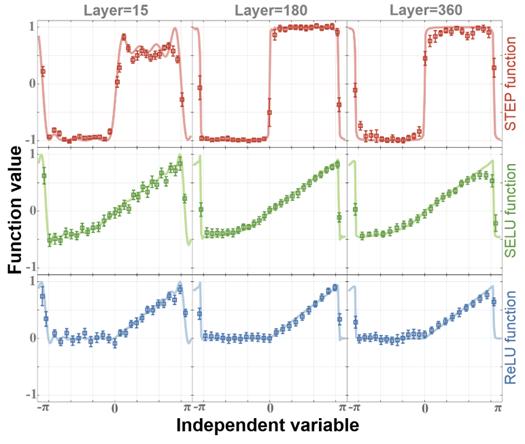Recently, a research team from the Innovation Academy for Precision Measurement Science and Technology (APM), in collaboration with the Hong Kong University of Science and Technology (Guangzhou), National University of Singapore, and Beijing Academy of Quantum Information Sciences, has for the first time experimentally demonstrated quantum signal processing circuits ranging from 15 to 360 operational layers using calcium-43 ions. This groundbreaking work reveals the operational limits of quantum algorithms on actual quantum hardware and provides crucial insights for future applications in quantum computing and quantum machine learning. This research finding was published online in Physical Review Applied, a renowned journal in applied physics, on March 25.
Quantum computing, as a disruptive technology, has emerged as a strategic high ground in global scientific competition. Its core advantage lies in harnessing quantum superposition and entanglement to solve complex problems intractable for classical computers. Currently, quantum computing is at a critical juncture characterized by co-advancement in hardware breakthroughs and application exploration. In this process, enabling quantum algorithms to operate efficiently and accurately on hardware platforms has emerged as the core challenge for technological implementation and industrialization.
Quantum Signal Processing (QSP) is a technique that performs polynomial transformations on input data through quantum circuits. Similar to classical signal processing, QSP leverages the superposition properties of qubits to efficiently simulate complex functions. QSP not only serves as the foundation for core algorithms like quantum singular value transformation, but is also widely applied in quantum phase estimation, Hamiltonian simulation, and the design of quantum neural networks. Through data re-uploading techniques (periodically updating quantum state information), QSP can approximate arbitrary single-variable functions using just a single qubit. However, as the number of quantum circuit layers increases, accumulated hardware noise leads to degraded precision. Previous experiments were largely confined to shallow circuits (e.g., tens of layers), while the actual performance of deep QSP circuits (e.g., hundreds of layers) remains an open question. This issue directly determines whether quantum algorithms can handle complex tasks on real-world devices.

Schematic diagram of energy levels in calcium-43 ions
The research team utilized laser-cooled calcium-43 ions confined in an ion trap as the experimental platform. The calcium-43 ion possesses a nuclear spin of 7/2 and exhibits a rich energy-level structure. Its hyperfine energy levels feature extended coherence times, making them an ideal platform for high-precision complex quantum operations (Fig. 1). By precisely manipulating microwave and laser fields, the researchers encoded quantum bits in specific energy levels of calcium-43 ions, constructing a 360-layer QSP circuit. This system successfully simulated key complex functions with broad applications, including step functions, self-normalizing activation functions, and rectified linear units.
The experiment revealed a critical trade-off between circuit depth and noise accumulation. When the circuit depth increased from 15 to 180 layers, the simulation accuracy improved significantly. However, beyond 180 layers, the effects of hardware noise—including decoherence and operational errors—became dominant, resulting in an unexpected accuracy degradation (Fig. 2). This phenomenon reveals fundamental limitations in quantum hardware when pursuing high complexity. Error analysis revealed two distinct noise regimes in QSP: operational errors dominated in shallow circuits but exhibited exponential decay with increasing depth, while decoherence errors accumulated rapidly in deep circuits, ultimately becoming the primary factor in accuracy degradation. This discovery provides a guideline for quantum algorithm optimization: dynamic balancing between circuit depth and error tolerance must be achieved according to hardware capabilities.

Experimental results of single-qubit complex function simulation. From top to bottom: step function, self-normalizing activation function, and rectified linear unit
Another key finding of the experiment was validating the guiding significance of single-qubit QSP circuits for multi-qubit extensions. The research team demonstrated that under noise-free input quantum states, the error metrics from single-qubit experiments can directly serve as lower-bound references for multi-qubit algorithms. This implies that single-qubit experiments alone can predict the feasibility of quantum algorithms in complex scenarios, significantly reducing verification costs. This conclusion provides a 'litmus test' for quantum algorithm design, preventing unwarranted system scaling under resource constraints.
Research results reveal a critical trade-off between function simulation accuracy and hardware noise accumulation, emphasizing the importance of balancing circuit depth and precision in practical QSP implementations. This work deepens the understanding of QSP—a fundamental quantum algorithm—regarding its scalability and limitations on quantum hardware, laying the foundation for and inspiring the development of quantum algorithms, including practical implementations of Quantum Singular Value Transformation (QSVT) and data re-uploading quantum machine learning models. With advances in quantum platforms such as trapped ions, neutral atoms, and superconductors, deeper and more complex QSP circuits are poised to play pivotal roles in quantum simulation and quantum linear algebra, thereby accelerating applied R&D in quantum machine learning and materials modeling.
This research was published in Physical Review Applied under the title “Exploring the experimental limit of deep quantum signal processing using a trapped-ion simulator.” Doctoral student BU Jintao from APM and ZHANG Lei from the Hong Kong University of Science and Technology (Guangzhou) are the co-first authors, with researcher FENG Mang, associate researcher ZHOU Fei from APM, and associate professor WANG Xin from the Hong Kong University of Science and Technology (Guangzhou) as the co-corresponding authors.
This research was supported by the National Natural Science Foundation of China (NSFC) through its Joint Fund Program and Major Research Plan Cultivation Project, among other funding sources.
Link to the article: Exploring the experimental limit of deep quantum signal processing using a trapped-ion simulator | Phys. Rev. Applied
